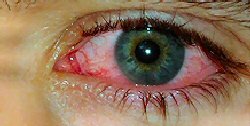Sleep In Contact Lenses
Should you sleep in contact lenses? Find out the risks here.
Most contact lens wearers, myself included, have fallen asleep at some stage with their lenses still in.
I actually slept in my soft two-week disposable contact lenses a couple of weeks ago when I was so tired I simply forgot to take them out...and I didn't even feel them still in my eyes!
But that doesn't mean it is safe to sleep in contact lenses, even though my particular brand of contacts can be worn either for 7 days continuously or for 2 weeks during the daytime only.
Extended Wear Sleep In Contact Lenses
Extended wear contacts are a great idea in principle. They were introduced to the US back in 1981 when the FDA approved certain lenses for overnight use.
Imagine not having to take lenses out every night to clean them or being able to wake up in the morning with perfect vision.
And what about the practical aspect for those with a job or lifestyle that makes it difficult to keeps hands and therefore lenses clean; sleep in contact lenses would seem to be the perfect solution.
Back in the 80s, I remember a work colleague who developed a serious eye infection from wearing 30 day extended wear lenses. They were new on the market and yes she was a bit lazy with her cleaning routine, but just looking at her bloodshot eyes, a serious case of conjunctivitis, put me off sleep-in contact lenses for life!
The problem back then was that extended wear soft lenses were designed to be worn for 30 days, then taken out to be cleaned and disinfected and then worn again for another month. Research soon proved that there was a far greater risk of eye infections, otherwise known as pink eye, among patients wearing 30 day contacts so the FDA changed the maximum wear time to just 7 days.
In recent years, advances in contact lens materials has meant that most sleep-in contacts are now disposable, lessening the risk of eye infections due to poor eye hygiene. And there are now some contacts that can be worn for 30 days as they are made from advanced silicone hydrogel which lets far more oxygen through to the cornea.
Even so, many opticians advise against extended wear sleep in contact lenses, due to the risk of developing pink eye syndrome.
Pink Eye Symptoms from Sleep in Contact Lenses
Typical pink eye symptoms include:
- pain
- itching
- stinging sensation
- gritty feel to the eye
- excessive tearing
- sensitivity to light
- burning sensation
- crusty eyes
- mucus build-up in the corner of the eye
 Pink eye
Pink eye
The result is an eye infection which could be contagious depending on the type of conjunctivitis. In contact lens wearers, it is most commonly caused by bacteria building up behind the lens and can be induced via poor hygiene and/or extended wear lens use.
It is extremely unpleasant, as this picture shows, and can mean that the wearer is prevented from wearing contacts, either ordinary or sleep-in contact lenses, ever again.
Related pages:






New! Comments
Have your say about what you just read! Leave me a comment in the box below.